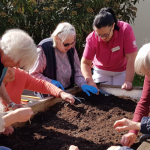‘With the quick stressbuster, anyone can do it,’ says Jasmin Beck. The sports therapist at AOK is responsible for prevention and relaxation at the health insurance company, and trains managers and people who work in care. “The quick stressbuster is a short moment to calm down,” says the expert about exercises on mindfulness. This could be, for example, the moment when you look out of the window into the greenery and let your gaze wander.
Short breaks, big impact
Or the first conscious sip from the coffee cup. Perceiving this, how the coffee or tea tastes, how the warm liquid flows down the throat, all this takes hardly more than three seconds. ‘But it is a simple mindfulness exercise that helps us to calm down,’ says Beck, who, among other things, trains professionals in nursing homes and outpatient care.
Racing thoughts
In stressful occupations, people often find themselves dwelling on the past – or already planning the next step. For example, geriatric nurses may wonder whether they gave the previous resident’s medication correctly while encouraging the person in front of them to get up. In the next moment, thoughts race into the future: What do I have to document in the duty room right away? And will I be able to take my breakfast break today? If the alarm button or the telephone rings, stress arises. If this stress is a permanent condition, there is a risk of physical and mental exhaustion in the worst case.
Mindfulness is relaxation for the brain

‘Those who are always working at full mental capacity cannot find peace,’ Beck explains. Yet it is precisely these short breaks that help the brain to relax. Those who manage to allow themselves seconds of downtime train their mindfulness. If care workers also manage to relax after work, their personal resilience increases. ‘Whereby it’s not necessarily about getting physical rest,’ says Beck, who is also a yoga teacher. ‘I, for example, go jogging several times a week, do Zumba and dance a lot to clear my head,’ the expert clarifies. Others find half an hour of meditation, pulling weeds in the garden or going for a walk helps.
Create me-time
‘Everyone has to find out for themselves what exactly helps them,’ advises Beck, pointing out that it is also possible to alternate active recovery through movement with resting on the sofa or listening to your favorite song while driving home. For many people, what is good for them depends on the day. However, it is important to take this ‘me time’ or to develop an awareness that it is time for your own needs. A sticker or post-it that reminds you of the me-moment can help. However, the note or button should not be stuck in the same place for more than two to three weeks. ‘After two to three weeks, the reminder becomes part of the furniture and loses its effect,’ says the expert. It needs a new place to tell us: ’Now it’s time to stop thinking for a moment!’
Everyday strategies for short mindfulness breaks
Those who do not dare to take a me-break in everyday life and under the scrutiny of bosses, colleagues or clients can also take their time out in the toilet. ‘Going to the toilet is socially accepted,’ says Beck. You can go there even if you do not have to. Incidentally, it is enough to incorporate an anti-stress quickie into your work twice a day. So do not put yourself under any pressure. And if you forget? No problem! Being kind to yourself is also an exercise on mindfulness. In mindfulness training, experts talk about regulating the level of alertness or vigilance. If this is reduced, we move closer to sleep from wakefulness, and that changes the brain waves. ‘We relax,’ says Beck. The inner carousel of thoughts comes to rest.
Signals to the environment
Those who manage to be more mindful of themselves also send signals to those around them. Instead of being lost in thought in another time, mindful people are attentive. ‘It has something to do with appreciation,’ says AOK expert Beck. Those who manage to be in the here and now when talking or doing routine activities are signaling: you are important to me. Physical presence is then joined by mental presence. Which ultimately also makes sense. Those who consciously perceive more moments in their everyday lives will make their work more meaningful.

